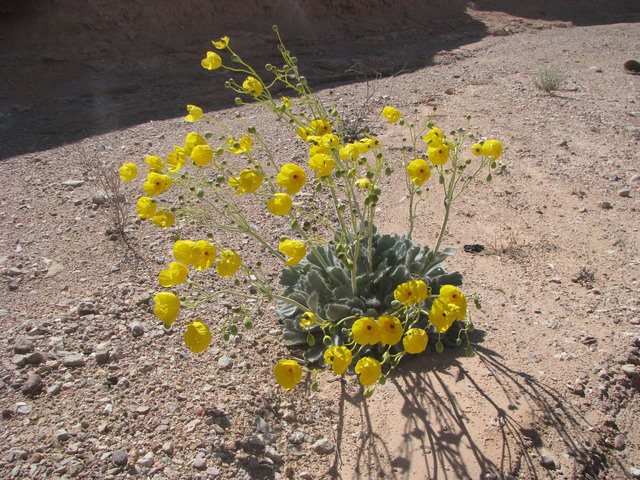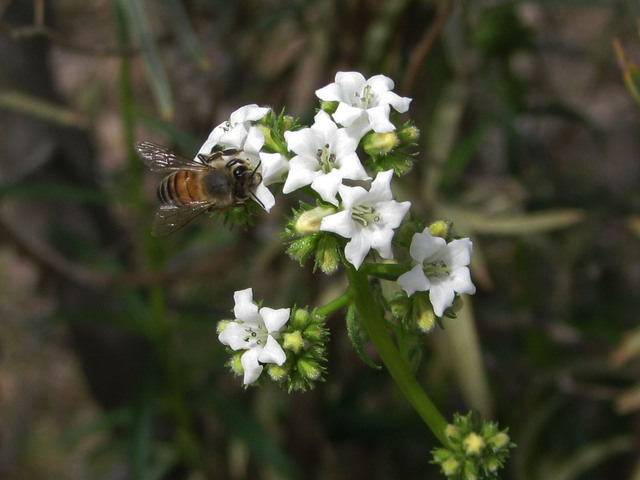Spring flowers a visual treat if you know where to look
The unusually mild winter has led to an early bloom in the valley.
The Joshua trees and the yucca have already bloomed, but there are still plenty of flowers to see a short drive away or perhaps right in your driveway.
“Many of the native and desert-adaptive plants are in bloom,” said Ann Edmunds, Master Gardener coordinator for the University of Nevada Cooperative Extension. “It’s a great time of year to come out to the Lifelong Learning Center and learn what they look like and learn from a Master Gardener how to plant them and care for them.”
The Lifelong Learning Center, 8050 Paradise Road, offers classes in many aspects of horticulture and includes a facsimile of a natural wash that is currently ablaze with blooms. The wash garden is irrigated from the center’s parking lot and roof runoff.
“A lot of the flowers you’ll see growing in the valley are growing in washes or alongside washes,” Edmunds said. “Anywhere you find a little water flowing through, you’re likely to find some variety of wildflower.”
For more information, visit unce.unr.edu, email lvmastergardeners@unce.unr.edu. or call 702-257-5555.
Another place to see a variety of blooming native and desert-adaptive plants that are conveniently labeled is the Springs Preserve, 333 S. Valley View Blvd.
“There are a lot of interesting plants in the valley, and a lot of them are in bloom,” said Brenda Rodriguez, lead groundsworker at the facility. “The bladder sage, the dogweed, penstemon and turpentine bushes are in bloom. A lot of the cacti are blooming, too, like strawberry hedgehog and the prickly pear.”
Rodriguez said the flowers on some of the varieties of prickly pear in the valley exhibit a seismonastic reaction, meaning that the pollen anthers, the part of the stamen that produces pollen, react to movement.
“If you run your fingertip in circles around them, they’ll close in on you like a sea anemone,” Rodriguez said. “That’s what it does to a bee. When it lands on the flower, it wants to stick as much pollen on the bee as it can before the bee leaves.”
For more information, visit springspreserve.org or call 702-822-7700.
The Clark County Wetlands Park, 7050 Wetlands Park Lane, also has a demonstration garden. Program assistant Nick Budnick said there are many plants in bloom in the garden and in the 2,900-acre park.
“The globe mallows are in bloom with orangish flowers,” Budnick said. “The blue flax has its brilliant blue flowers, and the arrow weed has purple or pink flowers. The pale wolfberry’s flowers are a yellowish, greenish creamy color.”
Budnick said it was unnecessary to go to great lengths to see many of the varieties of flowering plants in the valley. The creosote bush, with its bright yellow flowers, is a common sight in traffic mediums and vacant lots, and there many others that grow alongside roads.
“The valley’s elevation is pretty good for most plants, and that doesn’t really change until you get to about 6,000 feet,” Budnick said. “Any place that gets a bit of water and doesn’t have traffic on top of it can be a place for a plant to grow.”
For more information about the Clark County Wetlands Park, visit clarkcountynv.gov/wetlandspark or call 702-455-7522.
Much of the valley is checkerboarded with vacant lots or unoccupied structures. There may be wildflowers in those places that can be seen from the sidewalk without trespassing.
For those interested in observing flowers in a less urban location, there are many maintained dirt roads on the edge of the valley or just a few miles beyond. A four-wheel drive or high-clearance vehicle is recommended. Some of the more notable dirt roads and rural areas are to the west and east of the valley.
To the west, Rocky Gap Road passes from the loop road in the Red Rock Canyon National Conservation Area through the Spring Mountains. It is not a road for inexperienced, off-highway vehicle drivers, but it changes in elevation enough to offer different climates and flowers.
To the east, several dirt roads go from the south end of Hollywood Boulevard to Lake Mead Boulevard, passing behind Frenchman Mountain. Traversing the whole route requires an off-highway vehicle, but many expanses of flowers can be found just a few hundred yards up the roads. The area is perhaps one of the easiest places to see the endangered bear paw poppy, a small plant with yellow flowers that grows exclusively in Clark County.
To reach East Valley View reporter F. Andrew Taylor, email ataylor@viewnews.com or call 702-380-4532.
























